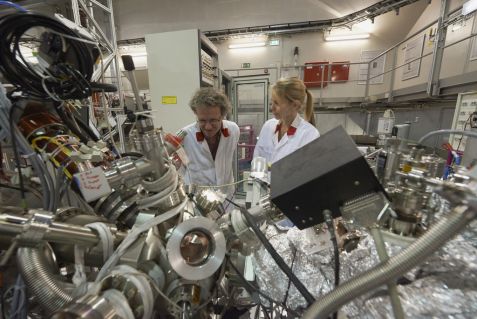MLZ is a cooperation between:
 > Technische Universität München
> Technische Universität München > Helmholtz-Zentrum Hereon
> Helmholtz-Zentrum Hereon
 > Forschungszentrum Jülich
> Forschungszentrum Jülich
MLZ is a member of:
 > LENS
> LENS > ERF-AISBL
> ERF-AISBL
MLZ on social media:

MLZ (eng)
Lichtenbergstr.1
85748 Garching
11.01.2016
Measure more accurately with positrons

Two of the authors, Christoph Hugenschmidt (left) and Samantha Zimnik (right) at the instrument NEPOMUC of the MLZ. © W. Schürmann /TUM
Physicists of the Heinz Maier-Leibnitz Centre and the Technical University of Munich have shown the enormous benefits of the Positron annihilation induced Auger Electron Spectroscopy (PAES) in the exploration of surfaces.
PAES is a newly developed method for the study of surfaces which allows the analysis of the elemental composition of the uppermost atomic layer of a sample. In PAES the emission of Auger electrons is initiated by positron electron annihilation. The scientists studied a polycrystalline palladium surface, covered with nominally half of an atomic layer of nickel, and compared the results with those of complementary research methods as the conventional Auger Electron Spectroscopy (AES) and X-ray Photoelectron Spectroscopy (XPS).
Detailed knowledge of the elemental composition of surfaces is extremely important, in order to understand processes taking place at surfaces such as catalysis. For instance, the chemical composition of a palladium surface decisively influences its catalytic ability and also plays an important role in the mechanical stability of thin membranes that are used for, e.g. hydrogen purification in industrial processes.
According to calculations, nickel on a palladium surface is expected to migrate into the second atomic layer. First AES measurements at a temperature of 550-800 °C confirmed this prediction. For their experiments, the scientists used palladium, which was covered on the surface with different amounts of nickel atoms. Using positron-electron annihilation they investigated how the composition of palladium-nickel changes over time and compared their results with those of AES and XPS. The positron-electron annihilation leads to the emission of photons with a total energy equal to the rest mass of the two original particles. The main advantage of PAES is that intrinsically almost exclusively the elements in the topmost atomic layer can be examined without a disturbing electron background. The second advantage is that this method does not destroy the surface of the object to be examined, which therefore can be used further.
Since the positron source NEPOMUC induced Positron Source Munich) at MLZ is the world’s most intense positron source with 109 positrons per second, the scientists succeeded to reduce the measurement time from several days to only a few minutes. Therefore, time-dependent PAES measurements can be carried out enabling the observation of surface processes. The scientists were able to clearly show a migration of nickel atoms into lower atomic layers, but could not prove unambiguously the accumulation of nickel atoms in the second atomic layer during the first measurement period.
“In the next step we want to investigate the time-dependent kinetics of this migration in detail,” explains Christoph Hugenschmidt, who is responsible for the instrument’s future plans.
Original publication:
S. Zimnik, C. Piochacz, S. Vohburger, and C Hugenschmidt; Time-dependent investigation of sub-monolayers of Ni on Pd using Positron-annihilation induced Auger Electron Spectroscopy and XPS; Surf. Sci. 643, 178
MLZ is a cooperation between:
 > Technische Universität München
> Technische Universität München > Helmholtz-Zentrum Hereon
> Helmholtz-Zentrum Hereon
 > Forschungszentrum Jülich
> Forschungszentrum Jülich
MLZ is a member of:
 > LENS
> LENS > ERF-AISBL
> ERF-AISBL
MLZ on social media:



